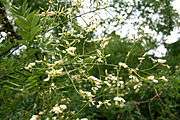Styphnolobium japonicum
| Japanese pagoda tree | |
|---|---|
 | |
| habit | |
| Scientific classification | |
| Kingdom: | Plantae |
| (unranked): | Angiosperms |
| (unranked): | Eudicots |
| (unranked): | Rosids |
| Order: | Fabales |
| Family: | Fabaceae |
| Subfamily: | Faboideae |
| Tribe: | Sophoreae |
| Genus: | Styphnolobium |
| Species: | S. japonicum |
| Binomial name | |
| Styphnolobium japonicum (L.) Schott[1][2] | |
| Synonyms | |
Styphnolobium japonicum (L.) Schott, the Japanese pagoda tree[3] (Chinese scholar tree, pagoda tree; syn. Sophora japonica) is a species of tree in the subfamily Faboideae of the pea family Fabaceae.
It was formerly included within a broader interpretation of the genus Sophora. The species of Styphnolobium differ from Sophora in lacking the ability to form symbioses with rhizobia (nitrogen fixing bacteria) on their roots. It also differs from the related genus Calia (mescalbeans) in having deciduous leaves and flowers in axillary, not terminal, racemes. The leaves are alternate, pinnate, with 9-21 leaflets, and the flowers in pendulous racemes similar to those of the Black locust.
Distribution

.jpg)
Styphnolobium japonicum is native to China; despite the name, it was introduced in Japan. It is a popular ornamental tree in Europe, North America and South Africa, grown for its white flowers, borne in late summer after most other flowering trees have long finished flowering. It grows into a lofty tree 10–20 m tall with an equal spread, and produces a fine, dark brown timber.
Uses
Gardening
The Guilty Chinese Scholartree was a historic pagoda tree in Beijing, from which the last emperor of the Ming dynasty, Chongzhen, hanged himself.
Traditional medicine

S. japonicum (Chinese: 槐; pinyin: huái; formerly Sophora japonica) is one of the 50 fundamental herbs used in traditional Chinese medicine.
Construction uses
Used to make the strong, springy curved "enju wood" handle used on the traditional Japanese woodworking adze, called the chouna.[4][5]
Medicinal properties
It is considered to have abortifacient, antibacterial, anticholesterolemic, antiinflammatory, antispasmodic, diuretic, emetic, emollient, febrifuge, hypotensive, purgative, styptic, and tonic properties.[6] Some components in the dried fruit showed antifertility action, haemostatic properties, anticancer, antitumor, antiobesity, antioxidation effects and had roles in the treatment of hypertension and haemorrhoids[7]. The fruit should not be taken during pregnancy. The dried flower buds are considered to have different medicinal properties from the dried ripe fruit. Toxic effects may include nausea, dizziness, vomiting, abdominal pain, hepatomegaly with abnormal liver function, haematuria, albuminuria, somnolence, spasms and coma[8].
Chemistry
The dried flower buds may contain as much as 20% rutin with some quercetin[9]. S. japonicum dried fruit contain the flavonoid glycosides sophoricoside, genistin and rutin and the flavonoid aglycones genistein, quercetin and kaempferol[7]. Another analysis found genistein and genistein glycosides including sophorabioside, sophoricoside, genistein-7-diglucoside, genistein-7-diglucorhamnoside, and kaempferol and the kaempferol glycosides kaempferol-3-sophoroside and kaempferol-3-rhamnodiglucoside[9]. The fruit also contain the alkaloids cytisine, N-methylcytisine, sophocarpine, matrine and stizolamine[8].
Chinese etymology
The Chinese name for the tree (槐) is composed of the word 木 ("wood") and 鬼 (representing a spirit in physical form "goust"). Generally is planted around the village edge, and in front of tample enternce.
References
Footnotes
- ↑ "Styphnolobium japonicum information from NPGS/GRIN". USDA. Retrieved 2008-02-19.
- 1 2 3 4 "Styphnolobium japonicum - ILDIS LegumeWeb". Retrieved 2008-02-19.
- ↑ "Styphnolobium japonicum". Natural Resources Conservation Service PLANTS Database. USDA. Retrieved 4 December 2015.
- ↑ "Japanese axes and adzes". Robin Wood. Retrieved 2012-02-24.
- ↑ "Beautiful axes, Japanese carpentry tools".
- ↑ "Sophora japonica - Plants For A Future database report". Archived from the original on September 30, 2007. Retrieved 2008-02-19.
- 1 2 Chang, L.; Zhang, X.X.; Ren, Y.P.; Cao, L.; Zhi, X.R.; Zhang, L.T. (2013). "Simultaneous Quantification of Six Major Flavonoids From Fructus sophorae by LC-ESI-MS/MS and Statistical Analysis". Indian Journal of Pharmaceutical Science. 75 (3): 330–338. doi:10.4103/0250-474X.117437. Retrieved 28 May 2017.
- 1 2 Bensky, Dan; Clavey, Steven; Stöger, Erich; Lai Bensky, Lilian (2015). Chinese Herbal Medicine: Materia Medica (Portable 3rd ed.). Seattle, USA: Eastland Press. pp. 575–578. ISBN 978-0-939616-82-4.
- 1 2 Tang, Weici; Eisenbrand, Gerhard (1992). Sophora Japonica L. Berlin, Heidelberg: Springer. pp. 945–955. ISBN 978-3-642-73741-1. Retrieved 28 May 2017.
General references
- The relationship of Sophora sect. Edwardsia (Fabaceae) to Sophora tomentosa, the type species of the genus Sophora, observed from DNA sequence data and morphological characters. Bot. J. Linn. Soc. 146: 439-446 (2004). Available online.
External links
| Wikimedia Commons has media related to Styphnolobium japonicum. |
- Sophora japonica
- "Chinese Scholar Tree"
- The Evil God in the Pagoda Tree Japanese folktale with the pagoda tree at hyakumonogatari.com
- Beautiful axes, Japanese carpentry tools in Europe